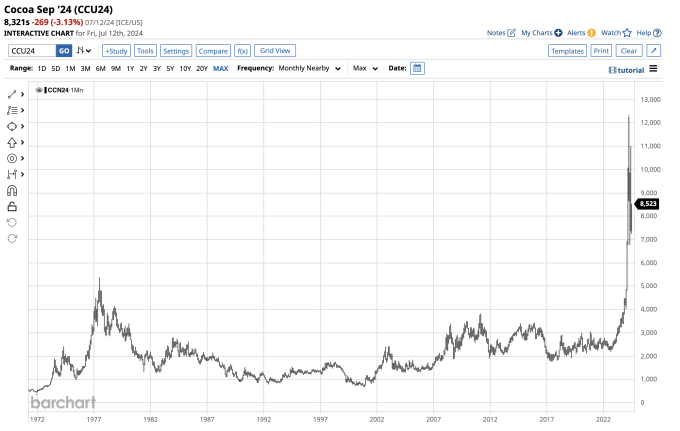After a 24.04% gain in 2023, the soft commodities composite fell 2.79% in Q2 and was 26.76% higher than the 2023 closing level. Cocoa and cotton led the way in the downside in Q2, with over 20% price declines. However, cocoa was over 84% higher since the end of 2023, while frozen concentrated orange juice futures were over 43% higher over the first six months of this year. Soft commodities are highly volatile. Cocoa and FCOJ reached new record highs in Q2.
Cocoa leads the way lower in Q2- Cocoa leads the way on the upside over the first half of 2024
Cocoa experienced an explosive rally in 2024 as West African supplies declined to levels that created a significant supply-demand deficit. While the price fell 20.86% in Q2, ICE cocoa futures were 84.20% higher than at the end of 2023 at the end of June.

The chart dating back to the early 1970s shows cocoa’s rally to a $12,261 per ton record peak in April 2024. Cocoa futures settled Q2 at $7,729 per ton at the end of Q2. Nearby September ICE futures were higher in early Q3. Cocoa was the best-performing commodity over the first six months of this year.
Cotton drops in Q2, after a Q1 gain
In May 2022, nearby ICE cotton futures rose to the highest price since the 2011 record high, reaching $1.5802 per pound. Cotton ran out of upside steam at the May 2022 high. In Q2, cotton fell 23.60% and was 13.81% lower since the end of 2023.

The continuous cotton futures chart shows cotton settled Q2 at 69.81 cents per pound as supplies have been adequate to meet the demand. December cotton prices are slightly higher in early Q3.
Coffee rallies in Q2- Sugar was lower in Q2, and since the end of 2023
Arabica coffee futures moved 21.23% higher in Q2, making it the leading soft commodity for the three months. The Arabica coffee futures were only marginally higher in Q1. They wound up 21.59% higher over the first six months of this year. The futures settled at $2.2895 per pound at the end of June and were higher in early Q3 at near the $2.50 per pound level. Technical resistance is at the February 2022 $2.6045 per pound high.
World sugar futures #11, free-market, unsubsidized sugar, moved 9.85% lower in Q1 and were 1.36% below the 2023 closing price after the first six months of 2023. The continuous world sugar futures contract settled Q2 at 20.30 cents per pound and were lower in early Q3.
FCOJ continues to soar
While cocoa futures were the star performer in 2024, they took the bullish baton from frozen concentrated orange juice futures, which reached new highs in 2023. The bullish price action continued in the FCOJ market as supply issues dominate the market. FCOJ moved 19.12% in Q2 and was 43.18% higher over the first six months of 2024.

The chart highlights the ascent to a new record $4.9525 high in May 2024. OJ futures settled Q2 at $4.3270 per pound, and the bullish price action is continuing in early Q3, with the price near the $4.50 per pound level.
The outlook for Q3 and beyond
Soft commodities were the leading sector in Q1 2024 and 2023. The sector took a rest in Q2 2024, with the composite slipping 2.79%. However, cocoa and FCOJ reached new all-time highs in Q2, and Arabica coffee futures rallied by over 21% over the three months.
As we move into Q3 and the second half of 2024, the overall bullish price action continues, with alternating softs taking the bullish baton.
Bull markets rarely move in straight lines., As we have seen in the cocoa futures market, explosive rallies tend to lead to implosive corrections. However, even after a significant price plunge, cocoa remains higher than the previous record high from the late 1970s.
The trend is always your best friend and remains bullish in soft commodities. Cotton has been the laggard, and sugar futures have underperformed cocoa, coffee, and FCOJ. Time will tell if the two laggards become the leaders over the coming months, as their prices are at levels that could offer significant value in the current environment. While the CANE ETF product reflects the price action in the World sugar futures, coffee, cocoa, cotton, and FCOJ have no ETF or ETN products, making the futures and futures options the only investment or trading alternative.
Risk-reward dynamics are critical when positioning in any soft commodity, as the sector can be highly volatile.
On the date of publication, Andrew Hecht did not have (either directly or indirectly) positions in any of the securities mentioned in this article. All information and data in this article is solely for informational purposes. For more information please view the Disclosure Policy here.
Disclaimer: The copyright of this article belongs to the original author. Reposting this article is solely for the purpose of information dissemination and does not constitute any investment advice. If there is any infringement, please contact us immediately. We will make corrections or deletions as necessary. Thank you.







